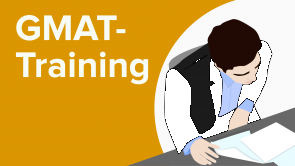(engl.) Introduction to the GMAT preparation (Chapter 1)
Über den Vortrag
Der Vortrag „(engl.) Introduction to the GMAT preparation (Chapter 1)“ von Robert Kuehl ist Bestandteil des Kurses „GMAT-Training“. Der Vortrag ist dabei in folgende Kapitel unterteilt:
- Signing-up and experiencing the GMAT
- What to expect on test day
- Test structure and scoring system
- Computer Adaptive Testing
- GMAT scoring system in practice
- Penalties for not anwering questions
- Score calculation method
- GMAT preparation - Best practices
- GMAT Books and other material
- Preparation time
- Error-Log
- Timing Strategies
- Using your Scratch Paper
Quiz zum Vortrag
What strategy is generally most promising for the Quantitative and Verbal Section of the GMAT?
- The first questions should be answered as conscientious as possible and the last questions, if necessary, should be solved by educational guessing.
- The first half of the questions should be answered as quickly as possible to definitely have enough time for all questions.
- The total time of 75 minutes should be split evenly among all questions.
- Never spend over 2 minutes for any question.
What parts of the GMAT count towards the so-called "Total Score", which ranges from 0 to 800 points?
- Only the Quantitative and Verbal Section
- The Quantitative Section, the Verbal Section and the new Integrated Reasoning Section
- Only the essay (Analysis of an Argument) and the Quantitative Section
- All parts of the GMAT
How much preparation time should you at least plan before taking the GMAT?
- 4-6 weeks
- 1-2 weeks
- 2-3 days
- 2-3 months
Why should you register at mba.com as early as possible, even though you do not yet want to schedule a GMAT appointment?
- To be able to download the official GMAT training software
- To get the GMAT newsletter and to be informed about changes in the test procedure
- To save costs
- To be prepared for the essay
What are the main sources for original GMAT test questions?
- The GMAT Review - Official Guide book and the software GMATPrep by mba.com
- Kaplan GMAT 800
- Internet forums
- The training CD by Manhattan GMAT
Diese Kurse könnten Sie interessieren
Kundenrezensionen
5,0 von 5 Sternen
| 5 Sterne |
|
1 |
| 4 Sterne |
|
0 |
| 3 Sterne |
|
0 |
| 2 Sterne |
|
0 |
| 1 Stern |
|
0 |
1 Kundenrezension ohne Beschreibung
1 Rezensionen ohne Text
Auszüge aus dem Begleitmaterial
... of 6 full-time test – Spotted and worked intensively on the weak areas (Error Log) – Average study time: 1,5 month full-time (some over 6 months). How they worked through the GMAT – Concentrated (and devoted more time) at ...
... you need to get started GMAT Overview Preparation Strategies. How to Prepare - The Official Guide 13th Edition Older ...
... 20%, 40%, 60%, 80%, 100% did not prepare less than 1 ...
... question together – leaving out all the unnecessary stuff GMAC puts in to disturb you – on geometry question, always draw a graph to scale. You can use the scratch paper as ...
... – Give the Answer Choices Letters from A-E – Divide and mark the Scratch paper at the time you see the directions – so you ...
... don’t understand one of those concepts you have to spot it, otherwise you will get it wrong every time it appears! Working through a thousand GMAT questions without spotting ...
... sample questions: – Break the GMAT Test-Questions from the Official Review into fixed packages of 5-10 questions – Take at least twice the time you have for the ...
... Didn‘t spot modifer. Always check for modifier/object agreement OG13 SC 12. Wrong choice between ...
.... question within the 2 minutes you might as well work on and try to find the solution in additional time, but note that you took over time (in your error log). To work on your timing you can also use this little ...
... start solving it and think if there is an easier way to solve it. Even before starting your calculation look at the answer choices and their distribution – how precise the calculations have to be. Don’t waste your time looking at the clock calculating ...




